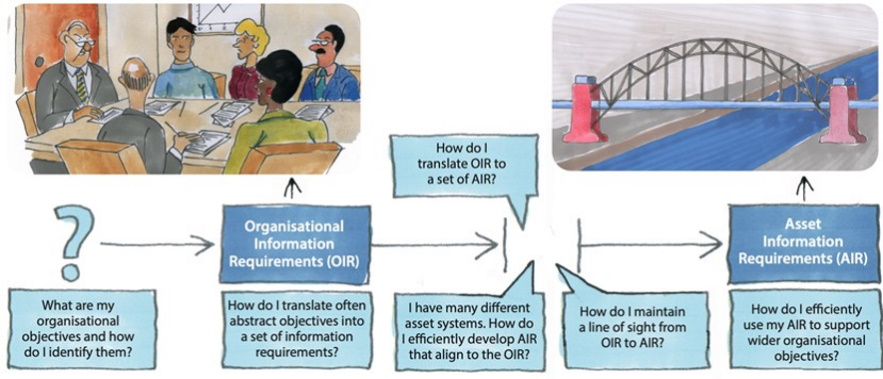
A newly published CSIC paper describes an innovative framework to help organisations create a ‘golden thread’ of information giving a line of sight to directly connect organisational objectives and asset requirements. Lead author Dr James Heaton, Digital Consultant at Costain, explains the need for the methodology and the benefits it brings.
The ‘Line of Sight: an Asset Management Methodology to Support Organisational Objectives’ paper was published on 30 July 2021 by the Centre for Smart Infrastructure and Construction (CSIC) and can be read here.
The paper, produced in collaboration with Costain and the Construction Innovation Hub (the Hub), describes a structured and repeatable approach to the development of Organisational Information Requirements (OIR) and Asset Information Requirements (AIR) within the context of an asset management organisation. One of the novel aspects of the methodology is the use of Functional Information Requirements (FIR) as a means to support the translation from OIR to AIR, enabling an organisation to realise the full potential and value of all of its assets.
This 10-page, accessible overview is aimed at all stakeholders, both technical and non-technical, across asset management organisations, and is the first result of a collaborative project by CSIC, the Construction Innovation Hub and Costain Group PLC.
The project builds on PhD research conducted within CSIC. The purpose of the project is to apply the results of the academic research within industry in the form of a web application, guidance and stakeholder engagement.
Why we need the Line of Sight Methodology
The success of an asset management organisation is in the realisation of the full potential ‘value’ of their assets. However, because these assets are often complex and can number in the thousands, measuring and monitoring their value is a complicated challenge.
This challenge results in a disconnect between the organisation itself and the assets they maintain and operate, with no direct line of sight between the Organisational Information Requirements (OIR) and the Asset Information Requirements (AIR). A line of sight between OIR and AIR will create a ‘golden thread’ for data and information and enable better-informed decision-making.
Industry standards such as the UK Building Information Modelling (BIM) Framework, the suite of BIM international ISO 19650 and Asset Management ISO 55000 provide definitions on OIR, AIR and Asset Information Models (AIM). However, while these standards describe what ‘shall’ be done, they are limited in providing any practical tools or frameworks to support the development of these requirements.
Furthermore, the research project noted that you can’t simply just ask people what information they require; it is erroneous to assume that individuals and organisations know what information they need. Therefore, there is a clear need for the development of a structured approach that supports an asset management organisation in developing its information requirements.
The Line of Sight paper
The paper provides a high-level overview of a line of sight methodology that utilises the concepts of Critical Success Factors (CSF) from Requirements Engineering and Plain Language Questions (PLQ) from BIM as a means to support the development of both OIR and AIR, with a structured and repeatable approach. Addressing the challenge of OIR generating AIR, a new set of information requirements at an asset’s functional output level is proposed to bridge that gap, these are called Functional Information Requirements (FIR).
Tried and tested
The Line of Sight Methodology discussed within the paper was tested within an industry case study by senior consultant Aaron Johnson from Jacobs on the Network Rail Transpennine Route Upgrade (TRU). While feedback noted that the methodology provided a structured approach to the successful development of information requirements, it was a resource-intensive task that would require a significant investment to be fully adopted.
The Line of Sight project aims to address this challenge by working on the following:
- Developing a self-serve web application for working through the methodology within a standard web browser
- Investigating the modification of the methodology into three discrete phases, to allow for efficient division of resource between senior management, asset managers and BIM/digital managers
- Demonstrating the incremental value created during the use of the methodology, thereby establishing a robust business case for its adoption
- Developing step-by-step industry guidance on the use of the methodology, including examples and processes to follow.
Next steps
The importance of achieving a clear line of sight between organisational objectives and asset requirements cannot be understated. The next steps for the Line of Sight Methodology will be to create an industry-friendly, less resource-intensive set of tools and develop guidance on its adoption. A number of industry trials are planned for this summer to generate feedback to the research team and provide expert input to participating organisations on the application of this methodology.
- Read the ‘Line of Sight: an Asset Management Methodology to Support Organisational Objectives’ paper here
- If you would like to know more about the Line of Sight Methodology tools and guidance and be kept up to date on next steps please email James Heaton at jrh212@cam.ac.uk or csic-admin@eng.cam.ac.uk

